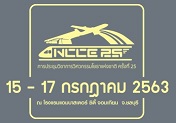Thermal Analysis of Reinforced Concrete Section Exposed to Fire
Temperature analysis, fire resistance time, reinforced concrete structure, fire
Abstract
This article proposes the simplified two-dimensional non-linear transient thermal analysis for temperature distribution in the reinforced concrete structure. The finite element method (FEM) is performed using the ANSYS software. In the model, the thermal properties of concrete such as thermal conductivity, specific heat, and density are used according to EN-1992-1-2. The purpose of the research is to investigate the fire resistance time of reinforced concrete structures exposed to the ISO834 standard fire curve under the temperature criteria. The beam, slab, and column with have the concrete covering according to the Thai Building Control Act (B.E. 2549) are considered.Based on the FEM results, the obtained temperature distributions are in agreement with the past experimental results. And, the concrete covering in accordance with the Thai Building Control Actprovides the fire resistance rate consistent with the value of fire resistance time proposed by the Thai Building Control Act.
Downloads
References
[2] Eurocode 2, (2004). EN 1992-1-2: Design of Concrete Structures, Part 1-2: General Rules—Structural Fire Design. European Committee for Standardization, Brussels, Belgium.
[3] กฎกระทรวงฉบับที่ 60. (2549) ออกตามความในพระราชบัญญัติควบคุมอาคาร พ.ศ. 2522.
[4] ธัญวัฒน์ โพธิศิริ (2558). การออกแบบโครงสร้างเพื่อความปลอดภัยด้านอัคคีภัย. สำนักพิมพ์จุฬาลงกรณ์มหาวิทยาลัย. 401 หน้า.
[5] ASTM E119-08a, (2008). Standard Test Methods for Fire Tests of Building Construction and Materials, ASTM International, West Conshohocken, PA, 31 pp
[6] Kreith, F., Manglik, R.M. and Bohn M.S., (2011). Principles of Heat Transfer. Cengage Learning, Colorado, USA.
[7] ANSYS Inc, (2011) ANSYS: A Finite Element Computer software and User Manualfor Nonlinear Structural Analysis. Canonsburg, Pennsylvania.
[8] Lie, T. T. and Irwin, R. J. (1993). Method to calculate the fire resistance of reinforced concrete columns with rectangular cross section. ACI Structural Journal, 90(1), pp. 52-60.
[9] Wade, C. A. (1993). Summary report on a finite element program for modeling the thermal response of building components exposed to fire. Building Research Association of New Zealand., BRANZ Study Report No. 51, Judgeford, New Zealand.
[10] Gao, W. Y., Dai, J. G., Teng, J. G., and Chen, G. M. (2013). Finite element modeling of reinforced concrete beams exposed to fire. Engineering Structures, 52, pp. 488-501.
[11] Emberley, R. L. (2013). A study into the behavior of reinforced-concrete columns under fire exposures using spreadsheet-based numerical model. M.S. Thesis, Worcester Polytechnic Institute, Worcester.
[12] BS 476-20, (1987) Fire Tests on Building Materials and Structures – Part 20: Method for Determination of the Fire Resistance of Elements of Construction (General Principles). British Standards Institute, London, UK.
[13] Thongchom, C. Lenwari, A. and Aboutaha, R. (2019). Effect of Sustained Service Loading on Post-Fire Flexural Response of Reinforced Concrete T-Beams. ACI Structural Journal, 116(3), pp. 243-254.
Downloads
Published
How to Cite
Issue
Section
License
บทความทั้งหมดที่ได้รับการคัดเลือกให้นำเสนอผลงานในการประชุมวิชาการวิศวกรรมโยธาแห่งชาติ ครั้งที่ 25 นี้ เป็นลิขสิทธิ์ของ วิศวกรรมสถานแห่งประเทศไทย ในพระบรมราชูปถัมภ์



